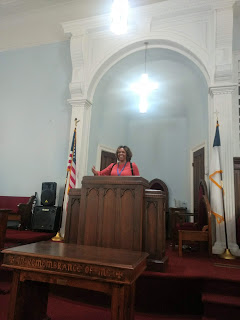This morning it was raining like it has been the whole night. When we arrived to Selma it was still raining. It's 54 miles east of Montgomery. We were hoping to visit the National Voting Rights Museum, which is located before the Edmund Pettus Bridge, but it turns out that it is closed Friday, Saturday and Sunday. We should have checked the schedule.
We look at the memorial dedicated to the Bloody Sunday, one more lesson on the Civil Rights Movement and their struggles, but also victories.
It was the year 1965 and the Civil Rights Movement activists were trying to upheld their constitutional right to vote. Jimmy Lee Jackson had been murdered by a state trooper. As a non violent protest, they organized to march from Selma to the state capitol Montgomery. On the first march, they hardly had time to leave town, when they were attacked by the state troopers and county posse men with billy clubs and tear gas. All this was televised and photographed, as 50 people ended up at the hospital. After public outcry, in 1965 the Voting Rights Act bill was passed.
We drove around Selma to check out the neighborhood. There were some beautiful homes, but some were abandoned and some had been burned down. Some businesses were boarded up.
We drove back to Montgomery to visit the Freedom Rides Museum. We were lucky to get the chance to meet one of the freedom riders, Dr. Ernest "Rip" Patton. He was talking to a group of students from Massachusetts.
His voice brought us back to a time where the rule of law had been abandoned. He talked about the Ku Klux Klan men and their compliance with the police, the Alabama government and the locals.
After Rosa Parks and the Montgomery bus boycott in 1955, which lasted 381 days, on November 13 1956, the Supreme Court upheld the district court's ruling, ruling that segregation on public buses and transportation was against the law.
To know the reason of the freedom rides, you just have to go to the bottom of the wiki page to the "Aftermath" chapter. There were bombing of churches, shooting on windows, harassing of African American bus riders, and if that was not enough a black man, Willie Edwards was lynched by the KKK. People were terrorized and ended up riding again in the back of the bus, if not even bother riding at all... therefore the Freedom Rides.
The first Freedom Ride was organized on May 4, 1961, and left from Washington DC and ended in New Orleans, going through Montgomery, and all the states that were still using Jim crow travel laws. The riders were 13 activists, seven black and six whites, some were women. The strategy was to have one black person seat in the 'white only' section of the Greyhound and Trailways buses, to test the system. They knew they were going to get hurt, put in prison or even killed, so they wrote their wills and goodbye letters before leaving.
Afterwards there were more freedom rides as more riders joined the movement, including many young students from various universities, and especially from the Nashville, organized in the Student Nonviolent Coordinating Committee (SNCC). Dr. Patton belonged to this group, which had already succeeded in the desegregation the whole city of Nashville. Some of them were expelled and could not continue their studies in the same university. Some of them ended up in the worst prisons in chain gang to work on cotton fields. The condition in county or city jail were terrible, and their jailers found pleasure and put extra effort to make their lives miserable.
Dr. Patton told us that they responded with songs and it sang some of them to us!
He told us the story of a girl, that went to help the victims of a bus bombing, with water and sponges. She was not put in jail because her parents told the police that she was 'touched' in the head, meaning that she was mentally disabled. She moved to Los Angeles after being ostracized by her community. She got involved with drugs for a while but now she is OK. This shows you how lives were affected and recovered with difficulties.
 |
| Dr. Patton |
 |
| Freedom Riders |
After the talk, we went on a separate room where we listened to testimonials from other freedom riders.























































